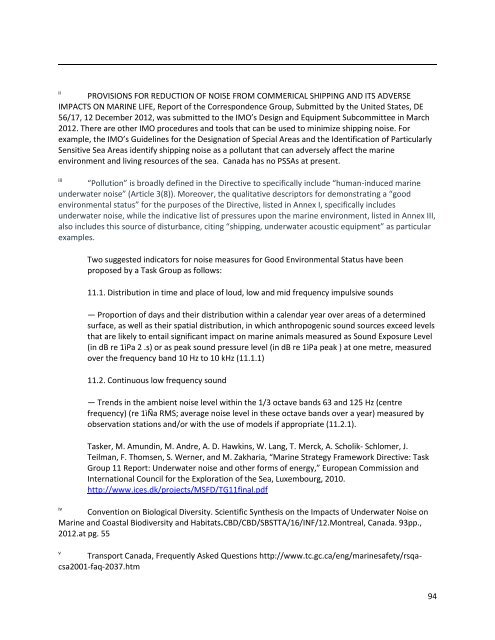mcbem-2014-01-submission-wwf-en
mcbem-2014-01-submission-wwf-en
mcbem-2014-01-submission-wwf-en
Create successful ePaper yourself
Turn your PDF publications into a flip-book with our unique Google optimized e-Paper software.
ii<br />
PROVISIONS FOR REDUCTION OF NOISE FROM COMMERICAL SHIPPING AND ITS ADVERSE<br />
IMPACTS ON MARINE LIFE, Report of the Correspond<strong>en</strong>ce Group, Submitted by the United States, DE<br />
56/17, 12 December 2<strong>01</strong>2, was submitted to the IMO’s Design and Equipm<strong>en</strong>t Subcommittee in March<br />
2<strong>01</strong>2. There are other IMO procedures and tools that can be used to minimize shipping noise. For<br />
example, the IMO’s Guidelines for the Designation of Special Areas and the Id<strong>en</strong>tification of Particularly<br />
S<strong>en</strong>sitive Sea Areas id<strong>en</strong>tify shipping noise as a pollutant that can adversely affect the marine<br />
<strong>en</strong>vironm<strong>en</strong>t and living resources of the sea. Canada has no PSSAs at pres<strong>en</strong>t.<br />
iii<br />
“Pollution” is broadly defined in the Directive to specifically include “human-induced marine<br />
underwater noise” (Article 3(8)). Moreover, the qualitative descriptors for demonstrating a “good<br />
<strong>en</strong>vironm<strong>en</strong>tal status” for the purposes of the Directive, listed in Annex I, specifically includes<br />
underwater noise, while the indicative list of pressures upon the marine <strong>en</strong>vironm<strong>en</strong>t, listed in Annex III,<br />
also includes this source of disturbance, citing “shipping, underwater acoustic equipm<strong>en</strong>t” as particular<br />
examples.<br />
Two suggested indicators for noise measures for Good Environm<strong>en</strong>tal Status have be<strong>en</strong><br />
proposed by a Task Group as follows:<br />
11.1. Distribution in time and place of loud, low and mid frequ<strong>en</strong>cy impulsive sounds<br />
— Proportion of days and their distribution within a cal<strong>en</strong>dar year over areas of a determined<br />
surface, as well as their spatial distribution, in which anthropog<strong>en</strong>ic sound sources exceed levels<br />
that are likely to <strong>en</strong>tail significant impact on marine animals measured as Sound Exposure Level<br />
(in dB re 1ìPa 2 .s) or as peak sound pressure level (in dB re 1ìPa peak ) at one metre, measured<br />
over the frequ<strong>en</strong>cy band 10 Hz to 10 kHz (11.1.1)<br />
11.2. Continuous low frequ<strong>en</strong>cy sound<br />
— Tr<strong>en</strong>ds in the ambi<strong>en</strong>t noise level within the 1/3 octave bands 63 and 125 Hz (c<strong>en</strong>tre<br />
frequ<strong>en</strong>cy) (re 1ìÑa RMS; average noise level in these octave bands over a year) measured by<br />
observation stations and/or with the use of models if appropriate (11.2.1).<br />
Tasker, M. Amundin, M. Andre, A. D. Hawkins, W. Lang, T. Merck, A. Scholik- Schlomer, J.<br />
Teilman, F. Thoms<strong>en</strong>, S. Werner, and M. Zakharia, “Marine Strategy Framework Directive: Task<br />
Group 11 Report: Underwater noise and other forms of <strong>en</strong>ergy,” European Commission and<br />
International Council for the Exploration of the Sea, Luxembourg, 2<strong>01</strong>0.<br />
http://www.ices.dk/projects/MSFD/TG11final.pdf<br />
iv<br />
Conv<strong>en</strong>tion on Biological Diversity. Sci<strong>en</strong>tific Synthesis on the Impacts of Underwater Noise on<br />
Marine and Coastal Biodiversity and Habitats.CBD/CBD/SBSTTA/16/INF/12.Montreal, Canada. 93pp.,<br />
2<strong>01</strong>2.at pg. 55<br />
v<br />
Transport Canada, Frequ<strong>en</strong>tly Asked Questions http://www.tc.gc.ca/<strong>en</strong>g/marinesafety/rsqacsa20<strong>01</strong>-faq-2037.htm<br />
94


